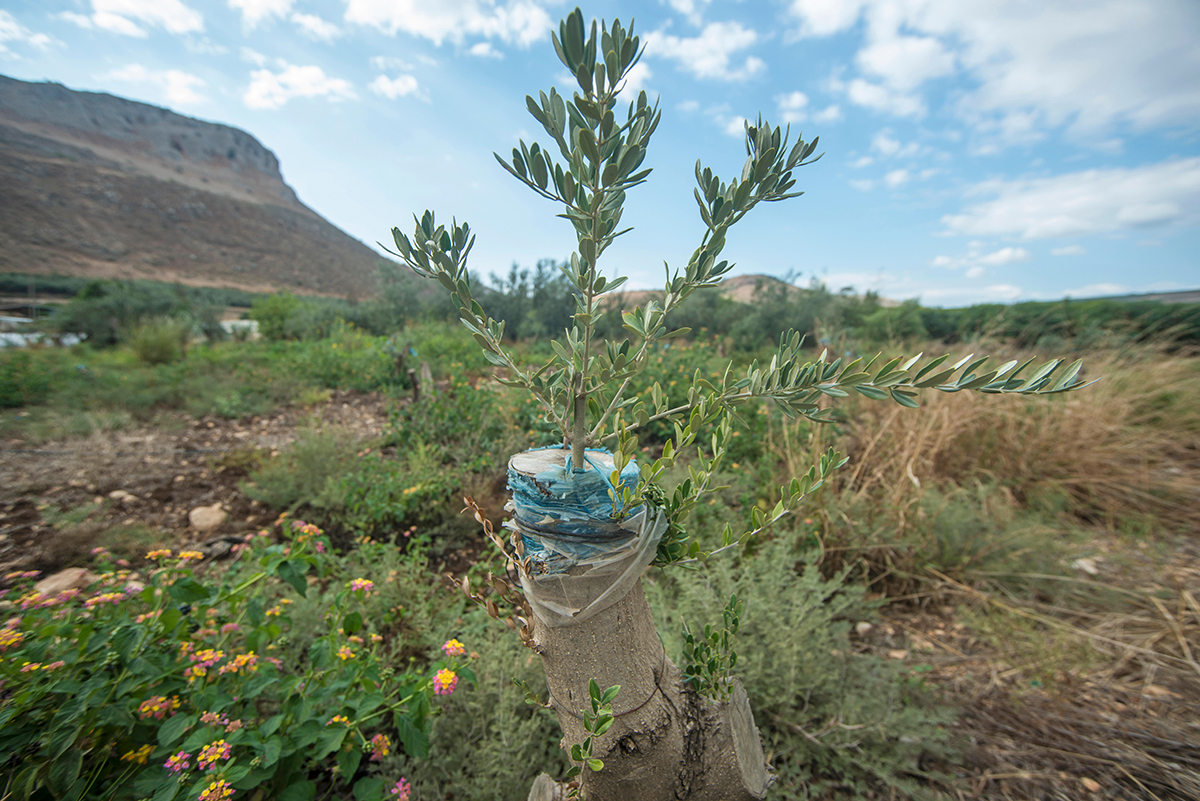Daisy Dunne
09.10.2018 | 3:15pmA key finding of the Intergovernmental Panel on Climate Change’s (IPCC) new special report is that it is likely that some degree of “afforestation” will be needed to limit global warming to 1.5C above pre-industrial levels.
Afforestation is a process where new forests are planted across land without trees. As a forest grows, it naturally removes CO2 from the atmosphere and stores it in its trees.
The technique has been described as one of the most “natural” and technologically simple of the “negative emissions technologies” (NETs) – a term describing a group of methods that aim to remove CO2 from the atmosphere.
However, others have raised concerns that afforestation could be costly, difficult to manage and could take up large amounts of land. Some point out that many regions are still grappling with deforestation and may not be able to protect new forests from destruction.
Here, Carbon Brief pinpoints the countries that invested the most into afforestation from 1990-2015. The article also looks at what regions have been earmarked for new forests in the future and to what extent afforestation could be used to limit global warming to 1.5C.
What does the map show?
The map above shows how the total amount of planted forest (in hectares) in each country changed between 1990 and 2015. This figure includes forests that were planted before 1990. Use the slider on the bottom left-hand side to see the total amount of planted forest in 1990, 2000, 2005, 2010 and 2015.
The data is taken from the most recent Global Forests Assessment undertaken by the United Nations Food and Agricultural Organization (FAO). The assessment considers a forest to be “newly planted” if more than half of its trees were established through deliberate seeding or planting.
It is important to note that the data does not distinguish between forests that were planted with the goal of tackling climate change and those that were grown primarily for another purpose.
In general, there are three different types of afforestation that are pursued by countries, explains Dr Charlotte Wheeler, a forests scientist from the University of Edinburgh.
These include: “natural regeneration” – the planting of native trees in an attempt to restore an area to what resembles a natural forest; commercial plantations – for either timber or a product, such as paper pulp; and “agroforestry” – the planting of trees for crop production, or the inclusion of trees in agricultural sites.
The amount of carbon that can be stored by each type of forestry varies widely, she tells Carbon Brief:
“Natural tropical forests are holding anywhere from 3-600 tonnes of carbon per hectare – you’re never going to get that level of storage within timber plantations.”

Naturally regenerated forests tend to be more carbon-rich than plantations for several reasons.
One is that natural forests contain a much larger plant species, which occupy different heights and spaces in the canopy. This means that natural forests are better able to capture sunlight – an ingredient essential to photosynthesis, a process in which trees absorb CO2 from the air and use it to build new leaves and shoots.
In addition, naturally regenerated forests are managed differently. Regenerated forests tend to be left on the land for long periods of time, allowing them to absorb more and more carbon.
On the other hand, timber plantations tend to be harvested every decade or so. If the harvested wood is used in construction, it can keep hold of most of its carbon. However, if it used as a fuel, this stored carbon will be released back into the atmosphere.
For agroforestry plantations, the amount of carbon stored depends on the chosen crop, Wheeler says. Common tree crops in the tropics include mangoes, avocados and cashew nuts, she says.
Other types of agroforestry, which include planting trees on cropland, could be a simple way to increase the carbon stocks of agricultural sites, she adds. However, this type of forestry would also not deliver carbon stocks that are comparable to those of natural forests.
World’s top tree planters
The chart below shows the countries that had the largest amount of planted forest area by 2015.
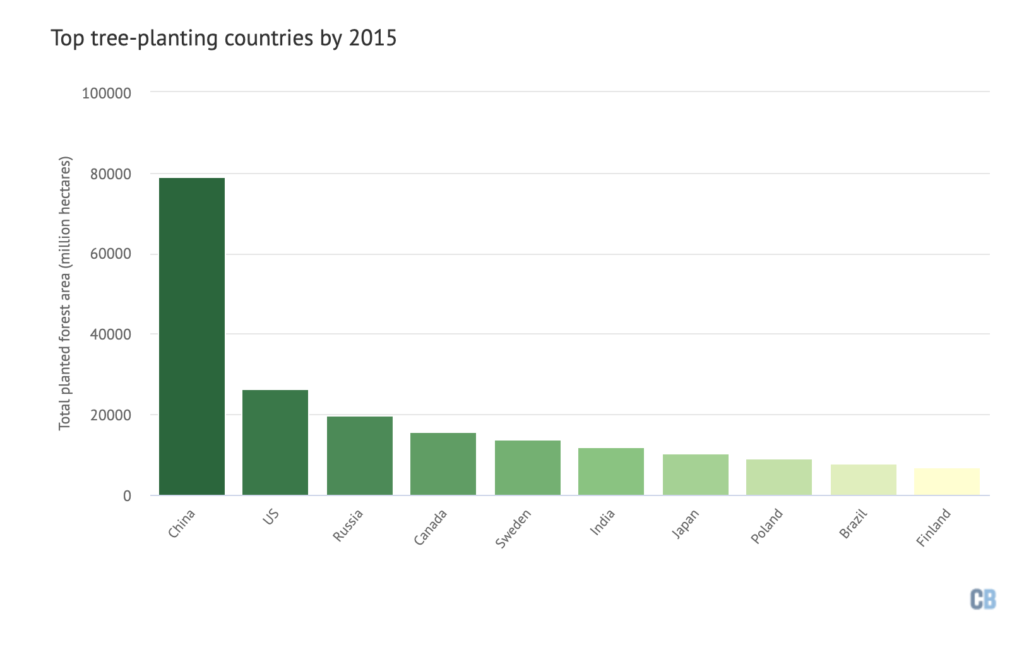
The picture looks a little different, however, if countries are ranked by the proportion of their total land area that is covered in planted forest.
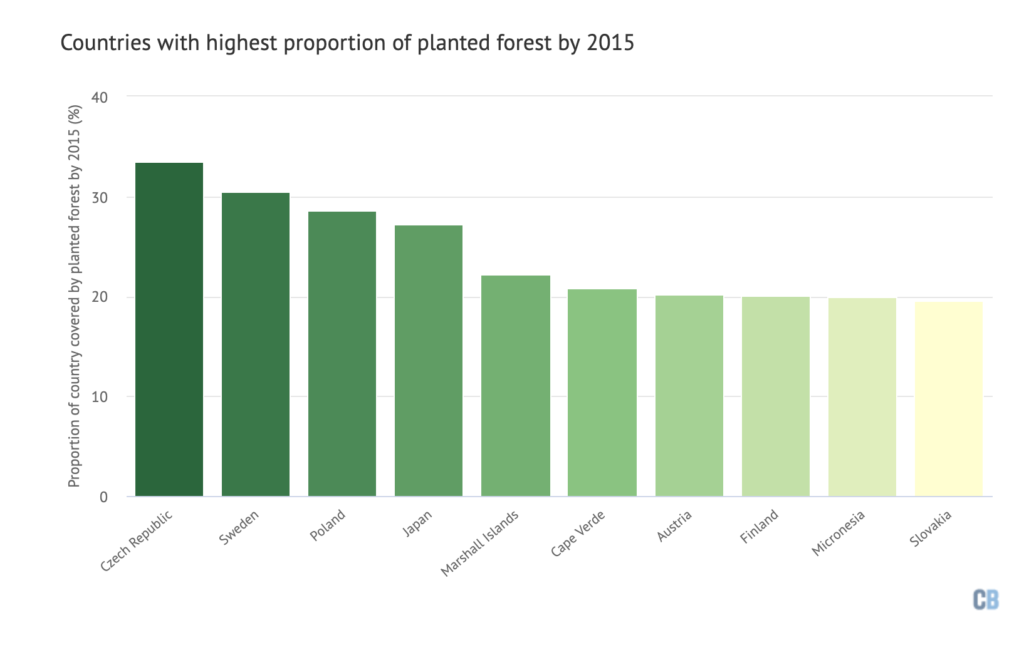
The map shows how, from 1990-2015, China planted the largest amount of new forest out of any country. By 2015, the amount of planted forest in China covered 79m hectares – an area more than three times the size of the UK.
Since the 1990s, China has invested more than $100bn in afforestation programmes and, according to its government, planted more than 35bn trees across 12 Chinese provinces.
Much of this planting was facilitated by the country’s “Grain for Green” programme – which pays farmers to transform their cropland into forest.
The leading motivation for this large-scale afforestation is to combat “desertification” – the degradation of fertile land into desert. Desertification inhibits farming and raises the risk of flash flooding.
Desertification in China has chiefly been driven by large-scale deforestation. Cutting down trees causes soils to become loose and vulnerable to erosion. As soil erodes away, the land becomes infertile and desert-like. Replanting trees can help to re-anchor and restore soils.
Research estimates that, from 1973-2003, newly planted forests in China absorbed around 774m tonnes of carbon.
The US has also invested substantially in afforestation. By 2015, the total area of planted forest in the US had reached 16m hectares. This has, in part, been driven by state-led efforts to bring new life to former mining areas, as well as by charities aiming to reduce CO2 levels and restore natural habitats.
In Africa, Sudan has seen the biggest increased in afforestation – with 6m hectares of planted forest by 2015. The country has seen a rise in “social forestry” – the planting of forests to meet the needs of local people, which is often facilitated by development funds.
Forestry projects in Sudan are often spearheaded by women, according to the FAO, and include the planting of gum Arabic trees – which produce sap that can be used as a food additive, or in the pharmaceuticals industry.
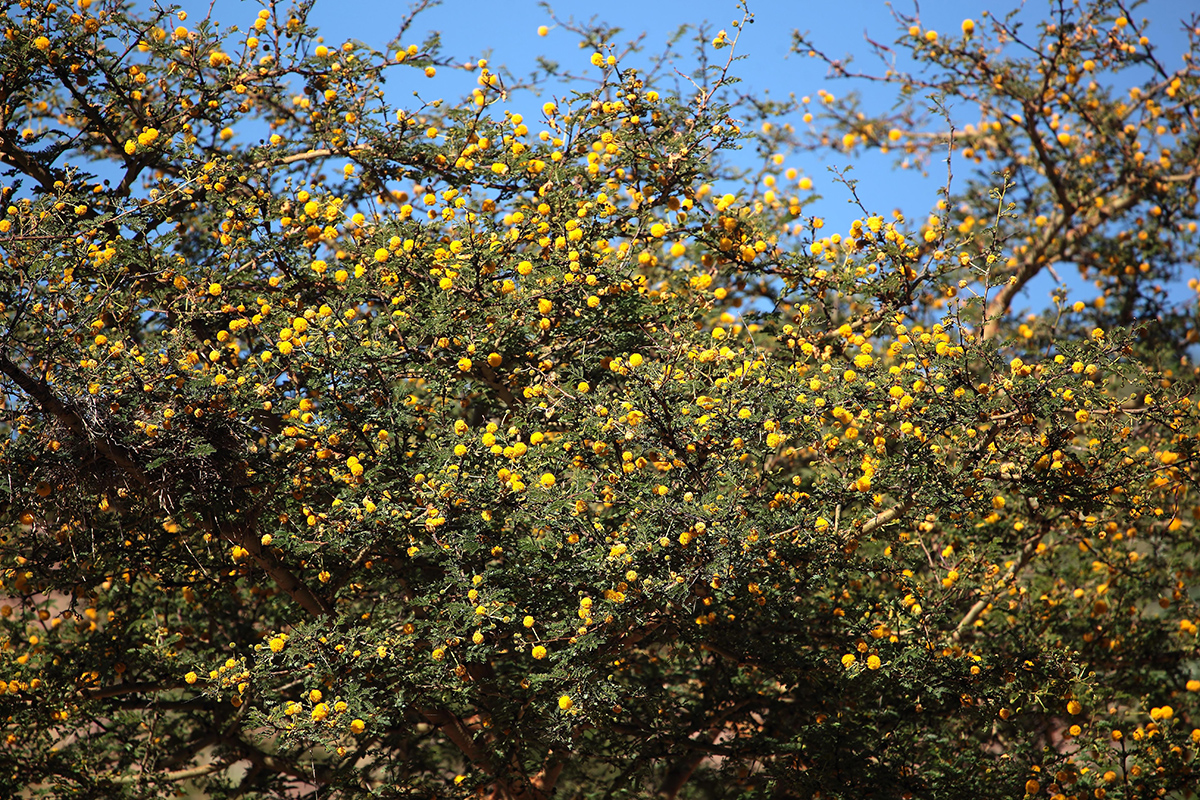
From looking at the map, it appears that much of the tropics has invested little in afforestation from 1990-2015. However, this is likely to change in the coming decades.
That is because, under the Bonn Challenge, 56 countries, many from central and South America and central Africa, have pledged to “restore” 350m hectares of forest by 2030.
The Bonn Challenge was launched in 2011 by the German government and International Union for the Conservation of Nature (IUCN). It was later endorsed at the 2014 United Nations Climate Summit.
The challenge anticipates that countries will follow a “forest landscape restoration” approach – which involves turning agricultural or pastoral land into forests by planting new trees.

If targets are met, it is estimated by the challenge’s benefactors that the new forests could collectively remove around 1.7bn tonnes of CO2e from the atmosphere each year from 2030. (Although scientists have raised doubts about this figure.)
Under the agreement, India has pledged to plant 21m hectares of new forest, while Ethiopia has pledged 15m hectares and Mexico has pledged 8.5m hectares.
Pakistan has pledged to plant a smaller 600,000 hectares of forest by 2030. However, Climate Home News recently reported how the new prime minister of Pakistan, Imran Khan, has promised a “billion tree tsunami” – by planting 10bn trees in the country in just five years.
In Africa, the United Nations is spearheading the “Great Green Wall” project – an ambitious plan to plant a wall of forest stretching across the width of continent just south of the Sahara desert. Once complete, it will be the “largest living structure on Earth”, its benefactors say.
Reaching 1.5C
The recently released IPCC special report on 1.5C finds that some use of NETs will be necessary to limit global warming to 1.5C.
In its summary for policymakers, it presents “four illustrative scenarios” showing how the world could limit warming 1.5C in the coming decades.
These scenarios range from a “low energy demand” scenario – where the need for NETs is minimised, largely through the adoption of energy-efficient technologies – to an “energy-intensive” scenario, where the world’s hunger for energy-intensive goods and services continues to increase in the coming decades. (More information on each scenario is available in Carbon Brief’s in-depth Q&A on the IPCC report.)
Each of these four scenarios, which are shown below, include the removal of CO2 from the atmosphere via changes to “agriculture, forestry and other land use (AFOLU)” (brown on the charts). The chief agent for CO2 removal from this group is likely to be afforestation.

The scenarios show how – regardless of how fast emissions fall – some degree of afforestation will be needed to keep warming to 1.5C and minimise the impacts of climate change.
Some scientists believe that afforestation should be seen as one of the most favourable options for removing CO2 from the atmosphere.
One reason for this is that it would be relatively simple to carry out compared to other proposed NETs – such as capturing CO2 directly from the air and storing it underground.
It also has the potential to offset large amounts of CO2. Research covered by Carbon Brief earlier this year found that the global reversion of non-forest land to forests could offset around 253bn tonnes of CO2 between 2018-2100. This is equivalent to around seven years’ worth of global CO2 emissions at current levels.
In addition, it has been touted by some as a “natural solution” to rising CO2 levels. It is argued that “natural” techniques may come with co-benefits for the environment, such as by providing new habitats for wildlife, and may be better received by the public.
However, others argue that afforestation would come with its own environmental challenges. A report released in January by the European Academies Science Advisory Council (EASAC) – a group that offers independent science advice to the European Union – highlighted some of these.
It noted that undertaking afforestation at scale would require a large amount of land-use change – which could reduce the amount of space available for wildlife and food production.
This concern was echoed in the IPCC’s special report, which noted that, even if steep emission cuts are pursued, afforestation would need to be carried out across 500m hectares of land – an area twice the size of Argentina – in order to limit warming to 1.5C.
A second report on NETs released earlier this month by the Royal Society and the Royal Academy of Engineering found that, in the UK, an area the size of the West Midlands in England would need to be converted to forest in order to meet climate targets.
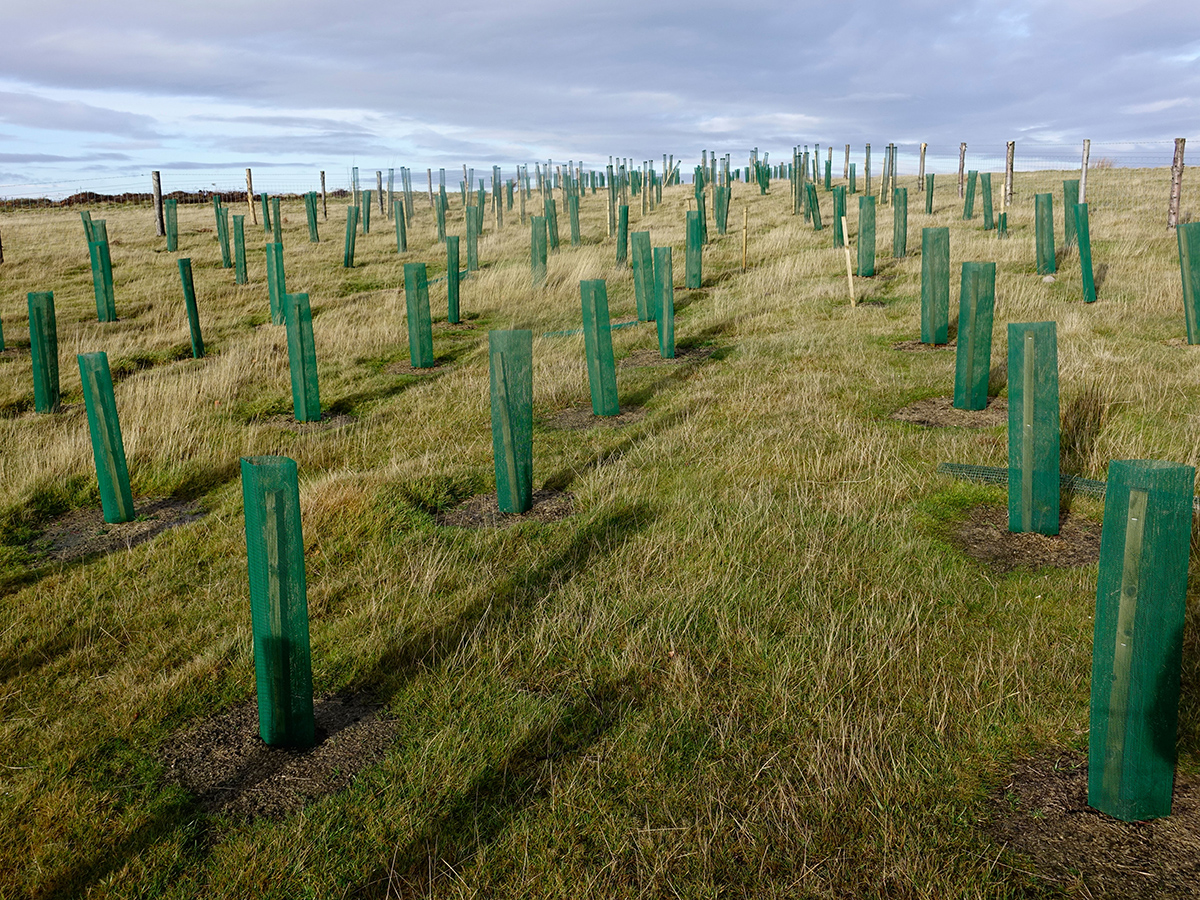
Scientists have reasoned that, in order to limit impacts on agriculture and natural forests, afforestation should be primarily undertaken on low-quality pasture and grassland.
However, growing forests in these landscapes would likely require the application of nitrogen fertilisers, the EASAC report notes. The production of nitrogen fertilisers releases a group of potent greenhouse gases known as nitrous oxides, along with CO2.
Another issue is that the carbon storage potential of afforestation greatly depends on what sort of trees are planted, says Dr Wheeler. While natural regeneration delivers the largest carbon stocks, other types of afforestation, such as agroforestry, may be more practical for local people in some regions, she says:
“It’s going to be a balance of what is realistic – we can’t turn every bit of land that was once rainforest back into native rainforest.”
However, recent research covered by Carbon Brief showed that simple actions – such as using a mix of tree species rather than a monoculture – could enhance the carbon storage potential of plantations.
An additional challenge is ensuring that planted forests are protected from threats such as illegal deforestation and wildfires.
Last year was the second-highest on record for tree cover loss, according to analysis from the World Resources Institute (WRI), with the world’s tropical regions losing an area of forest the size of Vietnam in just two years.
Such statistics should serve as a reminder of how difficult it is to protect forests, Prof Michael Norton, EASAC environment programme director, told a press briefing in January. He said:
“Forestation and reforestation offer simple ways of increasing carbon stocks, but it would be a mistake to be distracted from the reality of the current situation which is that…carbon is being lost by continuing deforestation.”
Map by Rosamund Pearce and Tom Prater for Carbon Brief
Updated on 9 and 10 October to clarify the definition of planted forest data and to add a chart showing which countries had the highest proportion of land covered by planted forests by 2015.


